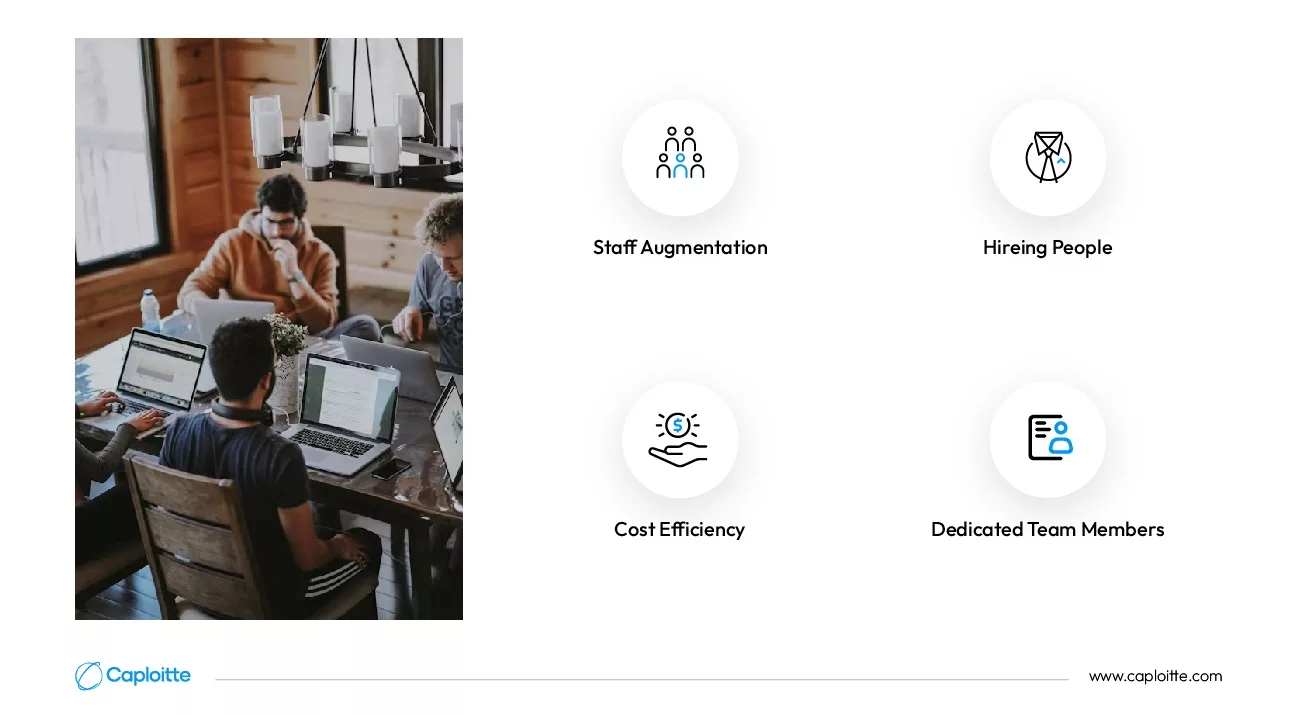Choosing the Right Outsourcing Model: Outstaffing vs. Outsourcing
-
Caploitte
-
25 Feb 2024
-
03 Min Read
What Is An Outstaffing Model?
What Is Outsourcing?
What distinguishes Outsourcing from Outstaffing?
Which one fits you the best?
The Reasons Why Companies Prefer to Outsource and Outstaff
Conclusion
The argument about outsourcing vs. outstaffing never ends. Businesses have to make that decision each time they need to develop a project or add a new feature. As businesses and startups want to expand and achieve quick growth, both outsourcing and outstaffing are in great demand. To maximize their software development budgets, more and more software businesses are relocating to remote, less expensive areas. It’s important to know when outsourcing makes sense for your business and when outstaffing is preferable.
This article is here to provide you with direction if you’re not sure where to go. Let’s investigate the opportunities that outsourcing presents. We’ll work together to choose the route that best suits your goals.
What Is An Outstaffing Model?

Businesses use software specialists from outsourcing businesses as part of the staff augmentation process known as “outstaffing” to strengthen their current teams. A sort of offshore web development occurs when a client employs a software outsourcing company contractor to handle development work. For the duration of their collaboration with offshore agencies, offshore developers may be considered to essentially work remotely as in-house developers for the client’s business.
Under this arrangement, the client company completely manages the outsourced developers while they remain at their places of employment. Outstaffing is typically the ideal option for clients that have a strong internal team and are looking to locate a specialist in a certain field or want to cut costs on employing employees. In this case, each member of the outstaff team would have a single customer. They don’t work on different projects as a result.
What does your company stand to gain from this kind of employment arrangement, and how is your outsourced project managed? For funding and overseeing your outsourced crew, there are two outstaffing methods. The “cost model” comes first, followed by the “cost plus” model. Here we’ll talk about both.
In a “cost” outstaffing ideal model, an IT services provider receives a one-time, fixed price from the customer in exchange for providing a part- or full-time employee for their outstaff team. The information technology services provider utilizes the money to cover the team member’s equipment costs, bonuses, perks, and compensation, among other things.
Since the information technology services provider has the discretion to allocate funds however it sees fit, the amount paid to an employee for pay or any other benefits is typically not disclosed to the customer. The advantage is that you save the administrative burden of managing your outsourced crew and you always know exactly how much you will spend each month.
You will have greater control over the compensation of your outstaff team members if you choose to use the cost-plus model for outstaffing development, but your costs may fluctuate more.
What Is Outsourcing?
Unlike outstaffing, outsourcing is a contracting procedure in which companies assign an outside company full responsibility for the available task. A sort of offshore web development occurs when a business (client) contracts out the whole project scope—from planning to development and testing—to another business, a software outsourcing company. This work plan is appropriate for all individuals, particularly company owners who wish to transition their existing profitable ventures to a more digital platform. Team management in outsourcing is handled by the offshore web development company. The hiring business does not have to keep up its IT skills while using outsourcing.
This work plan is appropriate for all individuals:
- For entrepreneurs just starting. For instance, you could wish to use the funds you recently obtained wisely to create an application, website, or other product, or you might need to submit an MVP to get funding.
- For company founders who would want to begin the software development process as soon as feasible without delving deeply into the technical aspects of the projects, outsourcing is an ideal model. It’s an ideal option for people who want to maintain control over their business but don’t have the time to devote to project development. Small businesses that want to test out new ideas may also benefit from outsourcing because it allows you to quickly test an idea and determine whether or not it needs to be developed further.
- For company owners who wish to expand their revenue streams by going more digital.
What distinguishes outsourcing from outstaffing?

What the differences are between outsourcing and outstaffing may be of interest to you if you’re thinking about either for your company. Of course, employing workers to work remotely is a component of both outsourcing and outstaffing, but there are some important differences to be aware of.
When a business contracts with another business to deliver goods or services it could otherwise create itself, this is known as outsourcing. On the other side, outsourcing is the practice of a business hiring staff members from another business to work for it.

Dedicated Team
The outsourced development service model that is most frequently misunderstood is the committed team model. It is perfect for companies that have long-term initiatives that call for particular skill sets. A committed offshore team comprises two or more excellent developers working on a specific project component. With this strategy, you hire a specialized offshore workforce that works just for you, effectively extending your in-house team. This gives you great influence over the path of your project while allowing you to capitalize on their experience.
A software outsourcing business oversees the developers in the specialized team they recruit, as opposed to outstaffing. Additionally, a specialized team is in charge of a particular step of the development process, in contrast to the outsourcing collaboration approach. For projects that need ongoing assistance, advancement, and creativity, the dedicated team model is a flexible yet controllable solution. After a while, the committed teams could turn into an outsourced development model. It often occurs when the client is pleased with the level of collaboration.
IT Staff Augmentation
A hybrid approach known as “IT staff augmentation” involves adding individual expertise to your team to enhance its capabilities. With staff augmentation, you can bring in experienced people to cover any gaps in your company’s knowledge. Staff augmentation might help you increase productivity if a new project calls for specialized technical expertise. It’s great for companies who need to keep control, have short-term needs for specialized expertise, or need to swiftly scale up or down their staff in response to project requirements. Having seasoned technical leaders in charge of the project is also crucial. Here, you have the freedom to manage the augmented team following your needs and can change the team’s size as necessary. Staff augmentation is an excellent option if you want to swiftly expand your development team. It might take time to hire full-time staff, and it’s not always the ideal model.
Offshore Development Center (ODC).
The ODC is managed and controlled by the client and serves as an extension of the customer’s own development team. Long-term collaboration is enabled by this paradigm, which also offers more control. It also gives you access to a larger talent acquisition pool and capitalizes on cost benefits.
Which one fits you the best?

Well, your business requirements hold the key to the fix. There are benefits and drawbacks to staff augmentation, project-based outsourcing, and dedicated teams. Your ideal model will vary depending on several things. Thus, begin by determining the issue that has to be resolved. The option that best meets the needs of your project should be selected.
Budget Plan: Where you should look to outsource might depend on the funding you allocate to a project. For instance, the lower it is, the more probable it is that you will have to search further for the best deals.
Timetable: Time is yet another crucial component. It will take time for you to manage your outsourcing partnership. While staff augmentation requires the greatest time, the project-based strategy requires the least. The kind of outsourcing arrangement that makes the most sense for your project will depend on its timetable. A fixed-price strategy would be ideal for a short deadline; for a longer one, a committed staff might be more effective.
KPIs: By sharing your KPIs with the outsourced staff, you enable them to fully comprehend your expectations for the working relationship. It will be simpler to hold the outsourced team responsible for the outcomes if you can be more detailed. Remember that to ensure that your performance criteria are fulfilled, you can also keep an eye on computer use by using a laptop or computer monitoring software.
If you have a well-defined project and are looking for an affordable solution, project-based outsourcing can be your ideal model. The dedicated team approach could offer long-term talent acquisition needing specialized talents the ideal mix of control and flexibility. Additionally, IT staff augmentation might be a great choice for companies that want specialized expertise for a brief period or speedy scalability. Everything is contingent upon the size of your project, the size of your internal team, and your desired level of flexibility.
The Reasons Why Companies Prefer to Outsource and Outstaff

Outsourcing one or more aspects of your company has a lot of advantages.
- Savings on costs
The main motivation for organizations to outsource is cost savings. When you combine outsourcing with offshore to inexpensive countries, using an outside vendor not only saves on basic salary for personnel but also on benefits and overhead for staff. Because labor costs are lower in various countries than in the US, outsourcing companies with international bases frequently offer their clients lower pricing. An outsourcing arrangement must be more cost-effective than what you would pay on an internal basis for the same degree of quality to be profitable.
- Adaptability and expandability
Outsourcing allows businesses that are expanding swiftly to make use of the position and experience of other organizations to grow their operations more quickly. Hiring someone to accomplish something in-house frequently won’t make economic sense if your business wants anything transitory or project-based. This explains why so many businesses contract out the creation of their websites and apps.
- Access to expert talent acquisition
Businesses that outsource stand to gain from their outsourced partner’s particular knowledge. They have far more expertise, knowledge, and advanced tools than a small to medium business (SMB) would normally have in that field because they only perform that particular business activity. Custom programming businesses have expertise in developing a wide range of software, and their programmers are up to date on the newest tools and programming languages.
- An edge over competitors
Competitive benefits come from outsourcing’s flexibility, specialized knowledge, and cost reductions. They could improve the caliber of your goods and services, enable you to swiftly capitalize on shifts in the market, and enable you to pass savings savings down to your clients in the shape of cheaper costs. The perfect outsourcing partner will actively provide recommendations to assist your business become even more competitive and will really view itself as a partner, not a vendor.
- The ability to concentrate on a core expertise
Businesses often perform a range of tasks on a daily basis that are either unrelated to or unrelated to their main business. While some monitoring of the outsourcing partner will always be necessary, having a capable and experienced partner will reduce the amount of time that must be spent managing the relationship. A company’s management and staff are free to focus more of their time and energy on the tasks that will have the most impact on the company’s financial performance and market success when some or all of these non-core duties are outsourced.
Conclusion
To put it briefly, outsourcing may be compared to a custom solution created to meet your unique requirements, objectives, and available resources. Once you find the appropriate fit, you can reap several benefits like as reduced costs, easier access to talent acquisition throughout the world, and most crucially, more time to dedicate to your main company. Finding an outsourcing business ideal model that increases cost effectiveness, makes use of specialized abilities, fosters seamless cooperation, and ultimately propels your company to success be made easier with the help of a methodical and comprehensive approach.
Share this post:
Read More
- All
- AI
- AR
- DevOps and CI/CD
- E-commerce
- FinTech
- IoT
- Mobile Development
- Outstaffing
- Security
- SEO
- Tech Trends
- Web Design
- Web Development




